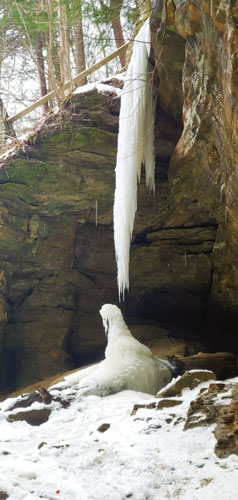About Outdoor Indiana
Outdoor Indiana, the state's premier magazine, delivers the wonders of the Hoosier outdoors to subscribers' homes and offices six times a year in 48 pages of vibrant color. For the best of state parks, lakes, wildlife, forests, trails, hunting, fishing, wildflowers and outdoorsy people, plus inside information from DNR experts, subscribe for $15 per year or $28 for two years. Follow the magazine staff on Facebook.
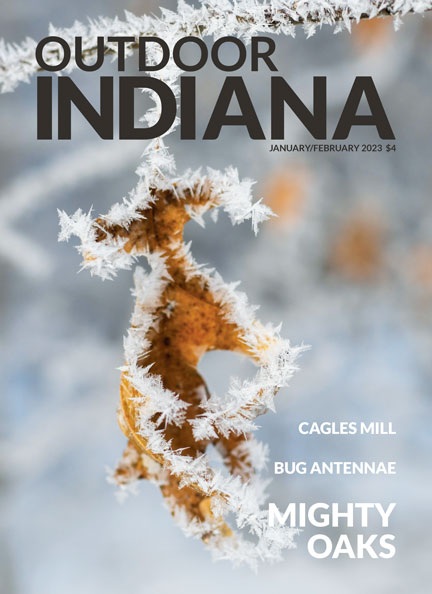
Hoarfrost covers an oak leaf in the early morning at Fisher Oak Savanna Nature Preserve in Jasper County.
Photo by Brent Drinkut.
Featured Stories
- FROM THE DIRECTOR
CALENDAR WINS NATIONAL TITLE

DNR Director Dan Bortner
As we look to the hope and promise of the new year, make sure to put spending more time outdoors at the top of your list of resolutions. Hiking, camping, fishing, hunting, birding, or seizing any of the other many opportunities the Hoosier state offers will always be time well spent.
Making memories with family and friends while being outside is a worthy goal of everyone who calls Indiana home. When you get visitors from across the state line, make sure one of your destinations is outdoors.This issue kicks off 2023 with a feature on Cagles Mill, the official U.S. Army Corps of Engineers name for the flood-control reservoir in Owen County near Cloverdale. The first such project of its kind in Indiana, you may know it as Cataract Lake or Lieber State Recreation Area. No matter what you call it, the lake turns 70 this year.
If you haven’t had a chance to explore this destination, then why not start there with your outdoor plans this year? If you’ve never been, it’s time to go, and if you have, it’s time to return. Located in central Indiana, it’s a doable drive no matter where you are in the state. And the state’s largest waterfall, Cataract Falls, is just 11 miles away.
Of course, there are many other DNR outdoor places to go, and winter offers long-range scenery other seasons don’t. Check out on.IN.gov/recguide for ideas. Watch for the printed new guide that will be available, free, all over the state, a week or two into February. It can help make this a Happy New Year!
- 70 YEARS OF FLOATING, FAMILY AND FUN
Cagles Mill Lake continues to deliver
By Scott Roberts, OI Staff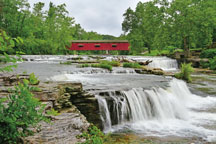
The historic Cataract Falls Covered Bridge spans Mill Creek’s flow through Cataract Falls State Recreation Area. Photo by John Maxwell.
As Jim and Valerie Buchanan of Greencastle guided their 1992 Starcraft pontoon boat around Cagles Mill Lake on a sunny September afternoon, Jim breathed a contented sigh and looked around.
“It’s just a pretty little lake,” he said. “We’ve had a lot of good times here. The lake’s changed a lot, but it’s never lost its charm.”
Buchanan should know. He and the lake are nearly the same age. He was born in 1952, and the reservoir’s construction ended in 1953. His parents took him to its shores before he was old enough to walk. Now he visits five days a week, when the weather is nice. He loves the nature, the quiet, and most of all, the community feel.
“I know a lot of people around here,” Buchanan said. “Tomorrow we’ll all be tied up together—we’re the pontoon crowd, gray-haired pontoons on patrol.”
Cagles Mill draws people in, he said, and doesn’t let them go.
To read the rest of this article subscribe to Outdoor Indiana or pick up a copy at one or our state park inns. To subscribe, click here or call (317) 233-3046.
- THE ULTIMATE MULTI-TOOL
Insect antennae have a variety of forms and functions
By Scott Roberts, OI staff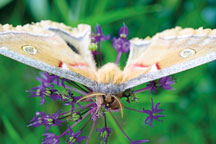
Promethea moths use large, feathery antennae to sense airborne chemical signals such as pheromones to lead them to a mate. Photo by John Maxwell.
For insects that have them, wings are usually the easiest parts of their body to notice. They are the generally the biggest and usually the showiest.
Take the promethea moth, for example.
The span of its wings is 3 to 4 inches, and the tan, white, and blue colors mixed with an eyespot in each wing’s center make for an attractive palette. This pattern helps the promethea moth mimic the pipevine swallowtail, a poisonous butterfly, warning predators to stay away.
But another part of this moth deserves just as much attention—its large, featherlike antennae. Their wispy shape is called plumose, and prometheas have them for a reason. Those wisps are adept at detecting chemical signals in the air the moth uses to sense temperature, air pressure, and most important for the species’ survival, pheromones. These pheromones help the insect find the location of a mate, which is especially important because the species lives for only a few days.
While many children grow up learning about antennae as an insect’s “feelers”, these tools can do so much more, as the promethea shows. Besides detecting scent and touching, other functions include hearing, balance, and tracking weather patterns.
To read the rest of this article subscribe to Outdoor Indiana or pick up a copy at one of our state park inns. To subscribe, click here or call (317) 233-3046.
- The Mighty Oak
From acorn to tree to restoration
By Marty Benson, OI staff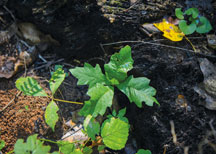
A seedling in the red oak family after a prescribed fire at Charles Spring. Photo by Brent Drinkut.
“Every majestic oak was once a nut who stood his ground.”
This anonymous proverb speaks figuratively to the potential within people and their ideas.
Sayings like it and others using oak trees as a metaphor work because an oak tree can last hundreds of years, surviving threat after threat—including fire—thus demonstrating perseverance.
The magic starts with a tiny, but in many ways equally mighty, literal nut.Oak is considered a keystone species because of the large effect it has on other plants and animals. In Indiana and many other places, no other tree family is as vital to wildlife. The overwhelmingly main reason is its nuts. That term (oak nuts?) may confuse at first, because no one else, except maybe a botanist would ever call the oak version anything but an acorn.
Unlike “nuts” that technically aren’t—peanuts, for example—an acorn is, botanically, a true nut. That essentially means it’s a hard, simple, dry fruit that doesn’t open to discharge seeds.
For the record, all oaks originate from acorns, and all acorns come from oaks. Only adult oaks produce acorns, a trait that plays a part in many other sayings regarding maturity that mention oaks.
Acorns are a wildlife food champion because they pack so much into such a relatively small, protected package that’s big enough to be readily found and gathered.To read the rest of this article subscribe to Outdoor Indiana or pick up a copy at one of our state park inns. To subscribe, click here or call (317) 233-3046.
Reader Photos
Each issue, Outdoor Indiana staff will select reader submitted photos to feature in the magazine. If you would like the chance to be featured, please submit your photo, along with your name and phone number to:
Please, only submit original photography that you have taken. Do not send files over 9 MB in size. JPG format is preferred.
Subscribe to Outdoor Indiana magazine
Visit the Indiana State Parks online store to subscribe. Cost is $15 for a one year subscription (6 issues) or $28 for two years (12 issues).
Donate
Printing and distribution costs for Outdoor Indiana magazine have increased. One way we’re offsetting these costs is through the Friends of Outdoor Indiana Group administered through the Indiana Natural Resources Foundation. Donations to our friends group helps keep our subscription price low and ensures we’ll be around to bring you the best of Indiana’s outdoors for years to come. Donate at the INRF website and include “Friends of Outdoor Indiana” in the “In Honor Of/In Memory Of” line.
Outdoor Indiana
402 W. Washington St., W255-B
Indianapolis, IN 46204
317-233-3046
OIorders@dnr.IN.gov


